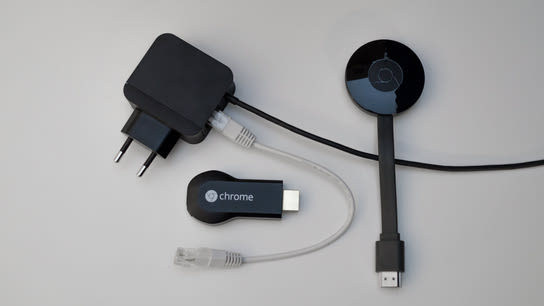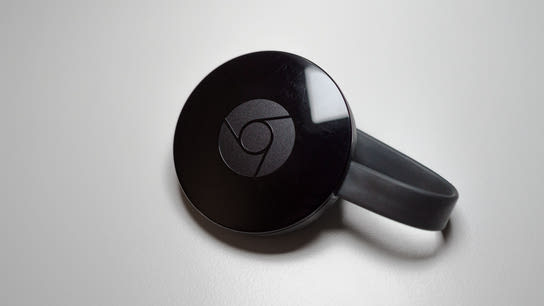Why get an Ethernet adapter for what is intended to be a wireless display device? Well, like me – you might live in an apartment complex where every neighbor has at least two Wi-Fi networks each. A lot of Wi-Fi signaling means your Wi-Fi may be unstable because of interference from all your neighbors’ networks. A wired network connection will ensure the Chromecast will get all the bandwidth it needs on your network.
The YouTube app on my Xbox One as well as the PlayStation 4 has been giving me trouble every evening for the last six months. The apps crash a lot, videos refuse to start playing, and it takes way to long to get the thing working. As I already use Android devices to queue up videos, I thought it would make sense to give the second-generation Google Chromecast a try.
I already have a first-generation Google Chromecast (the one that’s an HDMI stick with one rounded end.) The problem, however, is that the first-generation Chromecast only supports 2,4 GHz wireless networks, and those channels are seriously congested with some 380+ Wi-Fi networks in the immediate vicinity. Because of this, I hardly ever used the Chromecast and it was banished to the drawer of unused electronics after just a few weeks. The 5 GHz band isn’t as crowded yet, and the second-generation Chromecast finally supports this.
As I didn’t have much faith in the Wi-Fi experiment and I’ve a strong preference for wiring up my devices anyway, I ordered an Ethernet Adapter for Google Chromecast as soon as I got the new Chromecast.

The Ethernet Adapter for Chromecast replaces the regular power supply and provides both power and a wired network connection over the same Micro-USB connection. You simply swap out the power supply and stick an Ethernet cable in the adapter and run the cable into your router. It just works without requiring any configuration, though it can be hard to tell if the Ethernet Adapter is working. It worked flawlessly and effortlessly for me, but I wanted to make sure that it did its job too.
The Ethernet Adapter for Chromecast is compatible with both the first and second-generation Chromecast devices.
The adapter is compatible with legacy Ethernet (10BASE-TX) and Fast Ethernet (100BASE-TX) (10 and 100 MBit/s, respectively.) It will work with Gigabit Ethernet equipment, but can’t run up at those speeds. Fast Ethernet should be more than sufficient for streaming four 4 K video streams simultaneously. The network speed going from YouTube, over the Internet, and into your home is more likely going to be the constraining factor than the Ethernet Adapter.
It’s noteworthy, however, that the Chromecast theoretically supports Wi-Fi speeds up to 500 MBit/s over the 802.11ac standard. This assumes that you live an open field without any walls and no signaling interference under ideal weather conditions. Ethernet has a lower theoretical max speed but it has a much higher actual minimum speed and doesn’t suffer the congestion problem you may have with Wi-Fi.
The real benefit of the Ethernet Adapter for Chromecast is being able to side-step the whole Wi-Fi congestion issue. Streaming video is much more susceptible to temporary network issues or channel switching than other types of activities you carry out online (except for gaming, of course.)
You can use an app like Wi-Fi Channel Analyzer for Android to see how crowded all the Wi-Fi channels are around your home. (Sorry iOS users, Apple doesn’t want you to have toys like this app.) If there are few networks in range than you’re probably good, but the more networks there are the more interference you’ll experience with all your devices.
Using the Ethernet Adapter can theoretically help against the overheating problem reports that people are filling up the Google Product Forums with. I haven’t had a chance to verify this, but it stands to reason that you’d lower the operating temperature of the Chromecast by disabling the power-hungry internal Wi-Fi module and rely on networking being provided by a less power-intensive and external network module. The user manual for the Chromecast Ethernet adapter notes that the Ethernet Adapter can get quite hot with prolonged use, so make sure to ensure good ventilation around both the Chromecast and Ethernet Adapter to keep the devices cool.
Conclusion
Get the Ethernet Adapter for your Chromecast if you’re living in an apartment complex with lots of Wi-Fi hotspots all competing for dominance of your local area wireless. You may prefer to invite every neighbor to an arms race to see who has got the most powerful Wi-Fi transmitter. However, wiring up your lag-sensitive devices will probably cost far less and give you better results without making all your neighbors miserable. Assuming you can run an Ethernet cable up behind your TV, of course.
There isn’t much negative to say about the Ethernet Adapter for Chromecast except for its price. The Ethernet Adapter will cost you half the price of a Chromecast device! Google could just as well have included the Ethernet Adapter instead of the regular power supply with every Chromecast. I’m no expert, but the price difference of the components in the regular power supply that comes bundled with the Chromecast and the Ethernet Adapter seems to be less than 0,22 USD per unit (that is just the retail price before applying mass-production/bulk discounts.)
